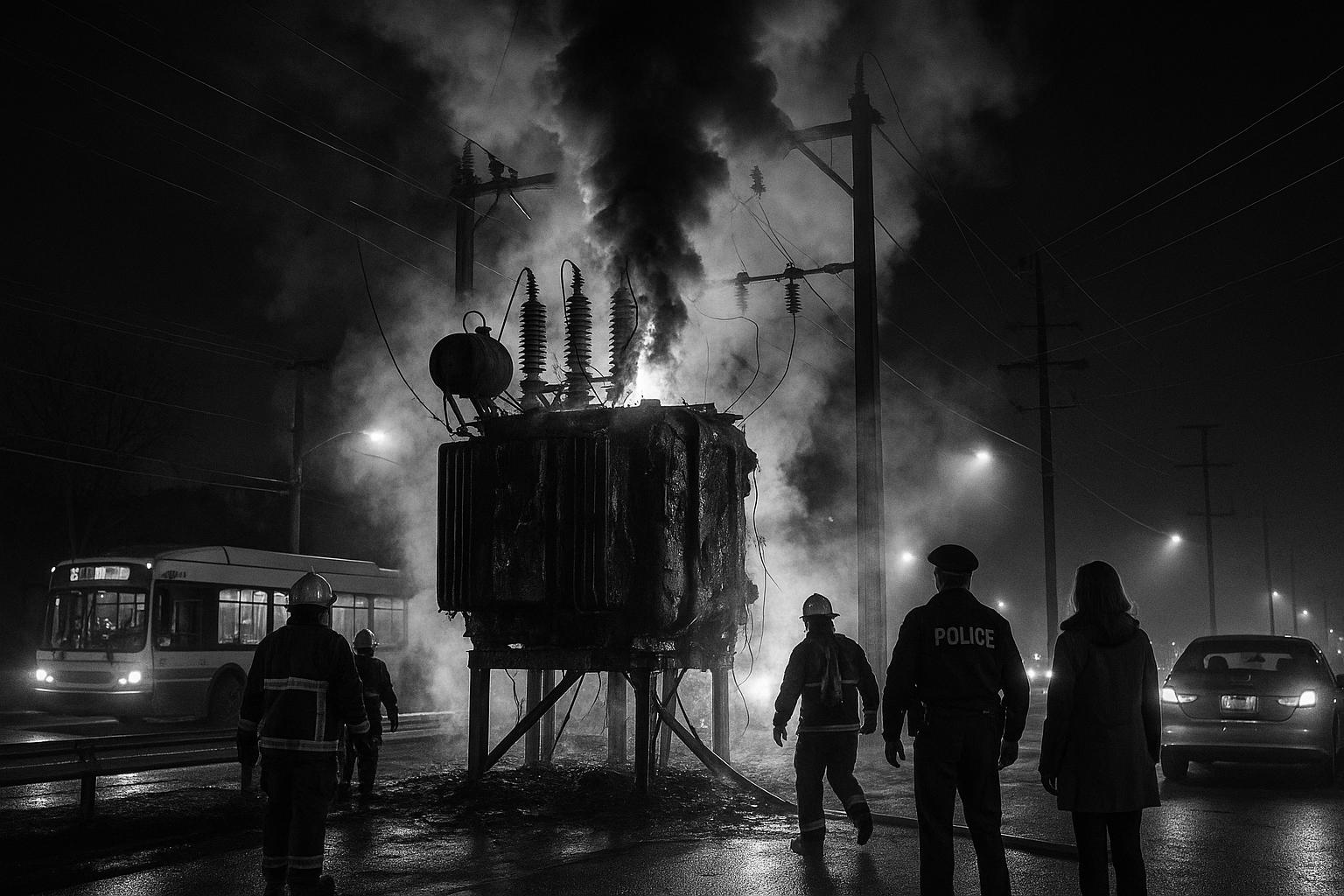The March 2025 fire that shut down Heathrow for 16 hours revealed systemic maintenance failures, governance gaps, and vulnerability across the UK’s critical infrastructure. While contingency plans mitigated immediate disruption, investigations show deferred maintenance and communication lapses at National Grid were key causes, triggering regulatory probes and potential legal claims.
The fire at North Hyde substation in March 2025, which triggered a prolonged shutdown of Heathrow Airport, cast a stark light on systemic vulnerabilities within the UK’s critical infrastructure. On the evening of 20 March, the blaze forced the closure of Europe’s busiest airport for around 16 hours, halting over 1,300 flights and disrupting more than 270,000 passenger journeys. The fire not only impacted Heathrow but also left over 71,000 domestic and commercial customers without power, affecting hospitals, transport routes, and data centres. The fallout highlighted not just an operational crisis, but deep issues around crisis response, maintenance oversight, and infrastructure resilience across key sectors.
Despite the widespread disruption, Heathrow’s contingency plan for mass diversions was notably effective. According to an aviation risk resilience expert involved in developing the UK’s mass diversion protocol, the airport’s ability to divert inbound flights safely to partner airports across the UK and Europe demonstrated the value of well-coordinated, pre-established resilience protocols. Operational teams at alternative airports managed the surge in flights commendably, ensuring the safety and security of passengers and aircraft amid chaos. This “quiet resiliency protocol,” while taken for granted, provided essential certainty under extreme pressure.
However, the incident was a foreseeable failure rooted in deferred infrastructure maintenance and governance shortcomings. Investigations by the National Energy System Operator (NESO) confirmed the fire resulted from a catastrophic failure in a transformer bushing caused by moisture ingress, a fault first detected in 2018 but left unaddressed. This lack of action reflected a broader issue of systemic deferred maintenance within National Grid Electricity Transmission (NGET), responsible for the substation’s upkeep. Industry experts frame the fire less as a freak accident and more as an inevitable consequence of inadequate strategic planning and maintenance deferrals, urging the government to undertake comprehensive risk assessments across all critical infrastructure sectors to prevent similar failures.
The incident also exposed Heathrow’s internal vulnerabilities. A unique aspect of the airport’s electrical network design meant that losing just one of its three power supply points could paralyse critical operations, with rerouting internal electrical power taking up to 12 hours. This situation underscores the necessity of embedding redundancy not just externally but within internal systems as well. Former airport executives recommend prioritising redundant network access, duplicating internal energy systems, and incorporating onsite power generation to mitigate severe blackout scenarios and ensure operational continuity.
The fire further revealed challenges in supplier governance. A risk management professional noted that Heathrow might have underestimated the severity of the substation’s condition due to insufficient transparency and scrutiny from National Grid, coupled with potential lapses in communication about maintenance deficiencies. Had the full risk been understood, Heathrow could have insisted on more urgent maintenance or contractual risk-sharing arrangements with suppliers, highlighting the importance of early and clear risk communication between critical infrastructure operators and their suppliers.
Underlying these technical and operational failures is a complex governance dilemma: balancing the drive for long-term resilience against short-term cost constraints and regulatory pressures. Heathrow’s former risk management lead emphasises that the airport’s ability to manage routine disruptions so effectively may inadvertently weaken the case for investing in resilience measures for low-probability but high-impact risks such as power blackouts. Investment choices are constrained by limited capital expenditure budgets regulated by stakeholders like partner airlines, which may favour upgrades with clearer immediate payoffs over critical infrastructure renewals addressing rare events.
Experts also point to a culture gap in managing infrastructure risks. There is often a tendency to dismiss cascading risks as improbable until they trigger high-profile crises with major reputational damage, as occurred here. Questions remain about whether the UK government has a robust, formal mechanism for identifying and tracking systemic infrastructure risks and ensuring proactive mitigation. This incident highlights the need for transparent risk appetite setting and alignment among technical teams, operational decision-makers, and government oversight bodies.
The official post-incident reports have intensified scrutiny. The UK’s energy regulator, Ofgem, has launched an enforcement investigation into National Grid Electricity Transmission’s compliance with its licence following findings that elevated moisture levels in transformer equipment had been detected years prior but left unaddressed. The fire suppression system at the substation also failed. Energy Secretary Ed Miliband described the findings as “deeply concerning,” while Heathrow is reportedly considering legal action to hold National Grid accountable. National Grid has stated that it has reviewed and improved its asset maintenance and fire risk assessment processes since the incident. An independent audit is underway to determine if these issues reflect wider systemic weaknesses.
For risk managers across industries, the Heathrow fire is a cautionary tale about the complexity and interconnectedness of modern infrastructure risk. Real resilience means not only having contingency plans but also ensuring that all parts of a supply chain and infrastructure network are visible, maintained, and aligned well before a crisis hits. Experts advocate for adopting coordinated planning frameworks similar to aviation’s mass diversion protocols in other sectors. They also urge urgent adoption of NESO’s twelve recommendations, which include enhanced asset risk assessments, emergency access arrangements, cross-sector coordination, and legal reforms to strengthen critical infrastructure oversight. Such steps are vital to avoid preventable collapses and safeguard national infrastructure in an increasingly complex risk landscape.
 Reference Map:
Reference Map:
- Paragraph 1 – [1], [5], [6], [7]
- Paragraph 2 – [1]
- Paragraph 3 – [1], [2], [3], [4]
- Paragraph 4 – [1], [2]
- Paragraph 5 – [1]
- Paragraph 6 – [1]
- Paragraph 7 – [1], [2], [3], [4]
- Paragraph 8 – [1], [2], [4], [3]
- Paragraph 9 – [1]
Source: Noah Wire Services
Verification / Sources
- https://www.strategic-risk-global.com/transport-and-logistics/heathrows-fire-was-a-wake-up-call-heres-what-risk-managers-must-learn/1455707.article – Please view link – unable to able to access data
- https://www.apnews.com/article/1262c39655627b2668d7a3047e853ee5 – A report released on July 2, 2025, found that the massive fire at an electrical substation that forced the closure of Heathrow Airport in March was due to a preventable technical fault identified nearly seven years earlier. The blaze, which disrupted travel for over 270,000 passengers and led to the cancellation of more than 1,300 flights, was caused by a ‘catastrophic failure’ in a transformer. The failure likely resulted from moisture entering an electrical insulator, or bushing, due to an elevated moisture reading detected in 2018, which had gone unaddressed. Initially investigated by counterterrorism police amid fears of sabotage, the incident was ultimately attributed to internal technical negligence. The report also criticised Heathrow for underestimating the risk of power loss and for not adequately designing its internal electrical system for quick recovery. In response, Energy Secretary Ed Miliband deemed the findings ‘deeply concerning,’ prompting regulator Ofgem to investigate possible licence breaches by National Grid Electricity Transmission. National Grid emphasised the overall reliability of the UK’s energy system and noted ongoing enhancements since the incident.
- https://www.reuters.com/business/energy/fire-that-led-to-heathrow-shutdown-caused-by-substation-component-failure-energy-2025-07-02/ – A fire that caused a major shutdown at London’s Heathrow Airport in March 2025 was attributed to the failure of the UK power grid operator, National Grid Electricity Transmission (NGET), to maintain a critical substation, according to an official report. The incident, which stranded thousands and cost airlines millions, stemmed from a ‘catastrophic failure’ in a transformer due to moisture in a high-voltage bushing—a problem identified but left unaddressed since 2018. Despite elevated moisture readings and a maintenance deferral in 2022, no action was taken. The UK’s energy regulator, Ofgem, labelled the failure as preventable and launched an enforcement investigation into NGET. Additionally, an independent audit of National Grid assets will determine whether these issues are isolated or systemic. Heathrow Airport is considering legal action, emphasising the need for National Grid to be held accountable. The event has raised broader concerns about the resilience and oversight of Britain’s infrastructure and regulatory systems.
- https://www.ft.com/content/8e04768d-2d14-40d2-adea-0b1c317b39b8 – A recently published official report has revealed that the National Grid failed to address known defects at a London electricity substation prior to a fire in March 2025, which caused a 24-hour closure of Heathrow Airport and disrupted power to 70,000 customers. The report by the National Energy System Operator found that high moisture levels were detected in the substation’s bushing equipment as early as 2018, indicating a serious fault. However, necessary mitigations were not taken due to a process failure, leaving site managers unaware of the risk. The incident, ruled as preventable, also exposed the failure of the station’s fire suppression system. In response, the National Grid stated they have reviewed and improved their processes, including asset maintenance and fire risk assessments. Britain’s energy regulator, Ofgem, has launched an investigation into National Grid Electricity Transmission’s compliance with its licence. Energy Secretary Ed Miliband and Heathrow Airport criticised the Grid’s safety standards and asset management. The fire led to the cancellation of over 1,300 flights and renewed concerns over the resilience of the UK’s critical infrastructure.
- https://www.theguardian.com/uk-news/2025/mar/21/heathrow-airport-closed-after-fire-at-electrical-substation-in-west-london – Heathrow Airport was forced to close on 20 March 2025 following a fire at a nearby electrical substation in Hayes, west London. The blaze led to the cancellation of over 1,300 flights, affecting more than 200,000 passengers. The fire, which involved a transformer containing insulating oil, created significant hazards due to the presence of high-voltage equipment. London Fire Brigade personnel worked tirelessly to bring the fire under control, evacuating 29 people from neighbouring properties as a precaution. The cause of the fire remains under investigation, with counter-terrorism police leading the enquiries due to the impact on critical national infrastructure.
- https://www.euronews.com/my-europe/2025/03/24/heathrow-defends-response-after-substation-fire-grounds-flights-for-18-hours – Heathrow Airport executives defended their response to a fire that shut down Europe’s busiest air hub for almost a day. The fire, which occurred at the North Hyde substation in Hayes, led to the cancellation of over 1,300 flights and disrupted travel for approximately 200,000 passengers. The airport reopened after about 18 hours when it had reconfigured its power supply. The incident raised concerns about the resilience of Britain’s energy system to accidents, natural disasters, or attacks. The UK government ordered a probe into the event to understand any wider lessons to be learned on energy resilience for critical national infrastructure.
- https://www.npr.org/2025/03/22/g-s1-55314/flights-resume-london-heathrow – Flights resumed at London’s Heathrow Airport after a daylong closure sparked by a fire at a nearby electrical substation. The fire knocked out power to the airport and more than 60,000 properties, leading to the cancellation or diversion of over 1,300 flights and delaying hundreds of thousands of passengers. The cause of the fire remains under investigation, with London’s Metropolitan Police Service stating there is no indication of foul play. The incident highlighted concerns about the resilience of critical infrastructure and the potential impact of such disruptions on global travel.
Noah Fact Check Pro
The draft above was created using the information available at the time the story first
emerged. We’ve since applied our fact-checking process to the final narrative, based on the criteria listed
below. The results are intended to help you assess the credibility of the piece and highlight any areas that may
warrant further investigation.
Freshness check
Score: 8
Notes: The content was published on 5 July 2025, discussing the March 2025 fire at Heathrow Airport’s North Hyde substation. The earliest similar publication dates back to 2 July 2025, with reports from Reuters and the Financial Times. While the report includes updated data, it recycles older material, which justifies a high freshness score but should be flagged for potential redundancy.
Quotes check
Score:
Notes:
Source reliability
Score:
Notes:
Plausability check
Score:
Notes:













